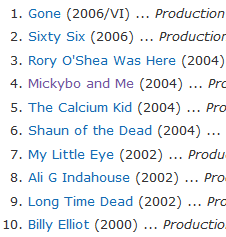[I'll be updating this with Warp/WT egs]
The film genre that is most associated with British cinema (costume/historical/heritage drama also: Elizabeth, Pride and Prejudice...). Features:
- Few films from the genre enjoy major box office success, because...
- they have low budgets, because...
- they rarely feature any stars (maybe some TV actors that are quite well known in the UK only, but not internationally), and even...
- often cast non-professional actors; This is England's Shaun (Thomas Turgoose) was a kid Meadows spotted bunking off school (truanting)!
- they often have no script, instead actos improvise - Ken Loach and Mike Leigh are famous for this approach, which makes it hard for them to convince studios to fund their films!
- whereas most successful, hit UK films are set in London/the South of England, these often use locations around the UK: Sweet Sixteen in Scotland, Mickybo and Me (WT2) in Northern Ireland
- most UK hit films also use middle or upper class characters, or central protagonists (all those Hugh Grant Working Title rom-com characters...), but social realist films typically centre on working [DE] (or lower middle [C2]) class characters: look at the opening shot of This is England, with the peeling wallpaper in Shaun's bedroom, or the opening scene of WT's debut film back in 1985, My Beautiful Laundrette, seeing the homeless lead being kicked out of a 'squat'
- Thats the 'social' bit of social realism - this generally means focussing on underprivileged or minority sections of society, including ethnic minority and sexual minority characters too (MBL's co-lead is a gay Asian man)
- the 'realism' bit comes from their documentary style: they aim to present 'the truth' about the country, not an idealised version that sells, and use documentary-style approaches to do so: handheld cameras, natural lighting, which of course also means...
- that, coming full circle, they are cheap to produce!
- See links below: the genre comes from earlier historical film traditions
British films that fictionalise real-life social issues, using a filming style similar to documentary (handheld, shaky, natural lighting, comparatively limited non-digetic music, usually unknown or minor actors). Developed out of the 1920s-40s BDM, 40s/50s Italian neo-realism, 50s/60s French New Wave, and British New Wave around the same time.
There are at least 25 posts on this blog which reference social realism; see also:
http://britrep.blogspot.co.uk/2010/04/britishness-miserable.html
http://www.theguardian.com/film/filmblog/2010/may/28/british-film-social-realism
http://www.screenonline.org.uk/film/id/1037898/
https://en.wikipedia.org/wiki/Social_realism#In_British_cinema
https://en.wikipedia.org/wiki/Kitchen_sink_realism
http://www.slideshare.net/tinkertaylor1981/british-social-realism-3986811 (teacher PowerPoint)
http://www.slideshare.net/hannahmedia123/codes-and-conventions-of-british-social-realism (student PowerPoint)
A classic BDM eg: Night Train (Watt & Wright, 1936) follows the journey of a mail train across Britain and the working men who see our mail gets delivered. [Watch on YouTube here.]
Here's some excerpts from a PowerPoint I've done (full version available on request)



















